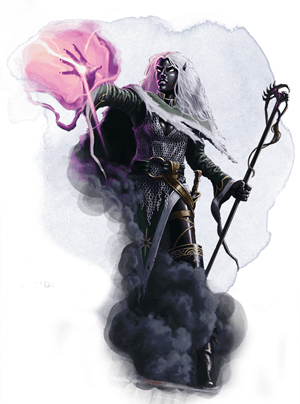 Drow make excellent villains. And as we saw earlier this week, they make compelling heroes, too. The fifth edition of Dungeons & Dragons even includes the drow as a subrace in the Player’s Handbook, and their mere inclusion encourages D&D players to consider them as heroic characters. Still, it’s not easy being a dark elf in the surface world. Let’s figure out how to make a backstory worthy of a great drow hero, and discover how you can fit a potentially disruptive drow character type into your campaign in the world above.
Drow make excellent villains. And as we saw earlier this week, they make compelling heroes, too. The fifth edition of Dungeons & Dragons even includes the drow as a subrace in the Player’s Handbook, and their mere inclusion encourages D&D players to consider them as heroic characters. Still, it’s not easy being a dark elf in the surface world. Let’s figure out how to make a backstory worthy of a great drow hero, and discover how you can fit a potentially disruptive drow character type into your campaign in the world above.
This article contains spoilers for the Dark Elf trilogy (1990–1991) and the Starlight and Shadows trilogy (1995–2003), and minor spoilers for Waterdeep: Dragon Heist and Out of the Abyss.
Drow and the Player’s Handbook
For the first time ever, drow make their appearance as character options in the Player’s Handbook, and are not condemned to being a “playable monster race,” with stats included in the Monster Manual, as they were in third and fourth edition. In fifth edition D&D, drow are presented as coequal with wood elves and high elves (though they are “rare,” and the book advises you to check with your Dungeon Master before playing one). Yet, the Player’s Handbook also has this to say of the drow:
THE DARKNESS OF THE DROW
Were it not for one renowned exception, the race of drow would be universally reviled. To most, they are a race of demon-worshiping marauders dwelling in the subterranean depths of the Underdark, emerging only on the blackest nights to pillage and slaughter the surface dwellers they despise. Their society is depraved and preoccupied with the favor of Lolth, their spider-goddess, who sanctions murder and the extermination of entire families as noble houses vie for position.
Yet one drow, at least, broke the mold. In the world of the Forgotten Realms, Drizzt Do’Urden, ranger of the North, has proven his quality as a good-hearted defender of the weak and innocent. Rejecting his heritage and adrift in a world that looks upon him with terror and loathing, Drizzt is a model for those few drow who follow in his footsteps, trying to find a life apart from the evil society of their Underdark homes.
Drow grow up believing that surface-dwelling races are inferior, worthless except as slaves. Drow who develop a conscience or find it necessary to cooperate with members of other races find it hard to overcome that prejudice, especially when they are so often on the receiving end of hatred.
This sidebar is effective in portraying all good-aligned drow characters as anomalies and setting them firmly in opposition with their evil homeland. But it may even go a step too far. It rightly cites Drizzt Do’Urden as the ur-renegade drow, but he is far from the only drow to reject the oppressive, slaveholding, back-stabbing, Lolthite ways of Menzoberranzan. Moreover, the other drow who have done the same rarely walk in his footsteps or look up to him as an example to be followed. Both Jarlaxle and Liriel Baenre turned away from their homeland for their own reasons, not because they looked up to Drizzt as a paragon of self-determination. Your drow needn’t do so either.
The Player’s Handbook only lists the barest of information needed to play a drow. If you wish to be a heroic drow, you ought to reject the cruel ways of Lolth, forsake the Underdark and the Lolthite metropolis of Menzoberranzan, and journey to the surface world, just as Drizzt, Jarlaxle, and Liriel did. But this is not the only way to play a drow.
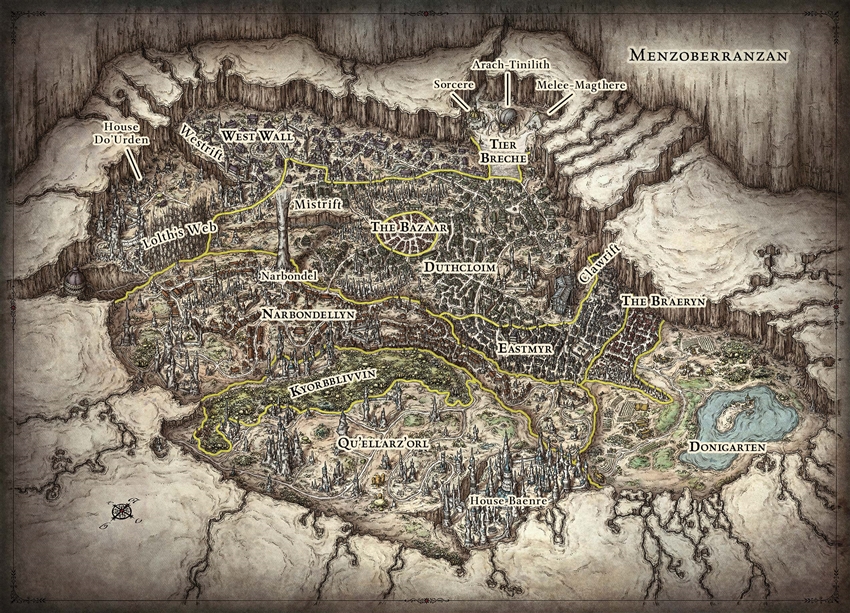
Mordenkainen’s Tome of Foes and Lights in the Darkness
The Player’s Handbook focuses on the most commonly iterated drow background: the Lolthite drow culture of Menzoberranzan. This is enough for most players, but Mordenkainen’s Tome of Foes expands beyond this simple starting point.
Beyond Menzoberranzan, dozens of other drow conclaves exist in the Underdark of Faerûn, and not all of them are beholden to the evil ways of Lolth. Take, for instance, the ruined city of Llurth Dreier, the City of Ooze. This wretched metropolis was once the most populous drow enclave in all of Faerûn, and its people were devoted to Ghaunadaur, an oozing, primordial god hated by both Corellon and Lolth. Ghaunadaur is a god of chaos and evil, just like Lolth and the vast majority of the gods of the drow. But his existence (and indeed, the existence of the other drow gods) hints at a greater culture beyond the Lolthite society presented as monolithic in the Player’s Handbook.
Motivation
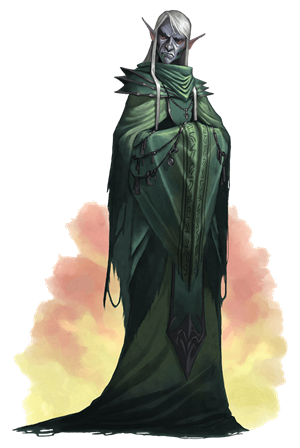 The most important thing to decide when making a drow character is what caused them to leave the Underdark. For example, Drizzt left Menzoberranzan because of the abuse he suffered at the hands of the treacherous Lolthite matriarchy, the dishonor he brought upon himself by denouncing Lolth—and because he had compassion in his heart. He spared the life of a surface elf when on patrol with his fellow male warriors, and he and his father Zaknafein attempted to flee Menzoberranzan together to escape the wrath of the priestesses of Lolth. Drizzt fled to the Underdark, but after forty years of fleeing his drow pursuers and suffering at the hands of illithids and other monsters of the darkness, he chose to escape to the surface.
The most important thing to decide when making a drow character is what caused them to leave the Underdark. For example, Drizzt left Menzoberranzan because of the abuse he suffered at the hands of the treacherous Lolthite matriarchy, the dishonor he brought upon himself by denouncing Lolth—and because he had compassion in his heart. He spared the life of a surface elf when on patrol with his fellow male warriors, and he and his father Zaknafein attempted to flee Menzoberranzan together to escape the wrath of the priestesses of Lolth. Drizzt fled to the Underdark, but after forty years of fleeing his drow pursuers and suffering at the hands of illithids and other monsters of the darkness, he chose to escape to the surface.
Likewise, Jarlaxle Baenre was once a respected member of Menzoberranzan high society, but defied its customs at every turn. His decision to stand apart from the rest of drow culture was not driven by altruism, as Drizzt’s was, but rather by his own opportunism. He chose to be unbound by society’s rules and expectations because it granted him freedom and power. He may have been an outsider and an outcast, but his charm and combat prowess helped him cultivate a mythic reputation that quickly made him one of the most powerful male drow in Menzoberranzan.
And Liriel Baenre, the eldest daughter of a mighty archmage of a powerful house, had all the power and status she could wish for. Her life was the height of privilege, and yet she chose to flee and live on the surface. Liriel learned that her instructor, Xandra Shobalar, was envious of her power and status, and sought to kill her. Even as she trained to become a priestess of Lolth, Liriel often journeyed to the surface world to escape the perils of drow society. Liriel was favored by Lolth despite her compassionate heart, but over the course of her adventures, Liriel was swayed from the Spider Queen’s worship and came to find strength in Eilistraee, drow goddess of freedom and goodness.
Gods of the Drow
Not all drow worship Lolth, but most drow gods are nevertheless agents of chaos and evil. Some drow gods oppose Lolth’s cruel matriarchy, such as Vhaerun the male drow god of warriors. He seeks gender equality among the drow, but only to advance his own selfish motivations. Dark elves who truly seek freedom from the gendered hierarchies of Menzoberranzan would do well to seek the worship of Corellon or other members of their elven pantheon, the Seldarine.
However, even drow who never leave the Underdark can find less evil gods to worship. Mordenkainen’s Tome of Foes names nine drow gods of the Dark Seldarine, the gods who joined Lolth in exchange for temporal power when she betrayed Corellon. See this sidebar from Mordenkainen’s Tome of Foes.
HOLES IN LOLTH'S WEB
Lolth is far from omniscient, despite what her priestesses say. There are drow who live without bending to the tyranny of her worship. Communities of renegades who dispute Lolth’s primacy often raise another of the Dark Seldarine up as their patron. Although this amounts to exchanging one evil oppressor for another, any escape from Lolth’s web can feel like freedom.
The Acropolis of Thanatos, erected in the ruins of a drow city wiped out by plague in the Underdark of Faerûn, was home to a drow settlement of a few thousand ruled by necromancer clerics of Kiaransalee. It existed for a few decades before worshipers of Lolth and worshipers of Eilistraee teamed up to eliminate its leaders.
Only two of the Dark Seldarine are not chaotic evil, but their worship is not as heretical in the Underdark as worshiping one of the Seldarine—let alone a human deity like Lathander. These two gods are Eilistraee and Zinzerena. Eilistraee the Dark Maiden is the more controversial among drow, as she is the goddess of moonlight, freedom, and most significantly surface-dwelling drow. Her alignment is chaotic good, and the Dark Dancer (as she is also known) is really the perfect deity for a drow player character… if they learned of her existence.
The high priestesses of Lolth keep the mere existence of Eilistraee a secret from their flock, for the knowledge of a daughter of Lolth and Corellon, and a compassionate and egalitarian one at that, could threaten the very fabric of drow society. Under Eilistraee, a matriarchal society (or at least a matrilineal one) could exist free of the oppression and discrimination enforced by the matron mothers and high priestesses of the Spider Queen. More information about Eilistraee and her worshipers can be found in Mordenkainen’s Tome of Foes.
Less controversial than Eilistraee is Zinzerena, a goddess of assassins, illusionists, wizards, and deceit. She is a goddess typically worshiped by the servants of the drow great houses, for Zinzerena represents an opportunity for advancement denied to them in Lolth’s rigid hierarchy. Zinzarena’s teachings encourage female drow to study arcane magic—something of a taboo in Menzoberrazan, as arcane magic is considered a lowly calling best suited for males—and most drow who worship this deceptive goddess do so in secret.
If this secret were to be revealed, a Zinzerenian might be scorned and face a minor scandal, but such shame is nothing compared to the fate of an unveiled Eilistraeean. Such a heretical drow would face exile at best. If Lolth herself were to witness such a betrayal, the offending blasphemer would be transformed instantly into a drider and be forced to live out the rest of their days in the caverns of the Underdark, never again to feel the sweet kiss of moonlight upon their silver hair.
Motivated by Deception
Of course, you don’t have to be a hero in D&D. You could very well play an evil drow in a party of otherwise good (or good-ish) characters. You could be a full-on Lolth worshiper who is in an alliance of convenience with the other party members. As long as your goals don’t involve directly undermining the party or their allies, you could even hide your villainy from your fellow characters the entire time. Remember, evil doesn’t mean psychotic. A Lolthite drow can lie in wait, like a spider tending to its web… only to strike at the perfect moment.
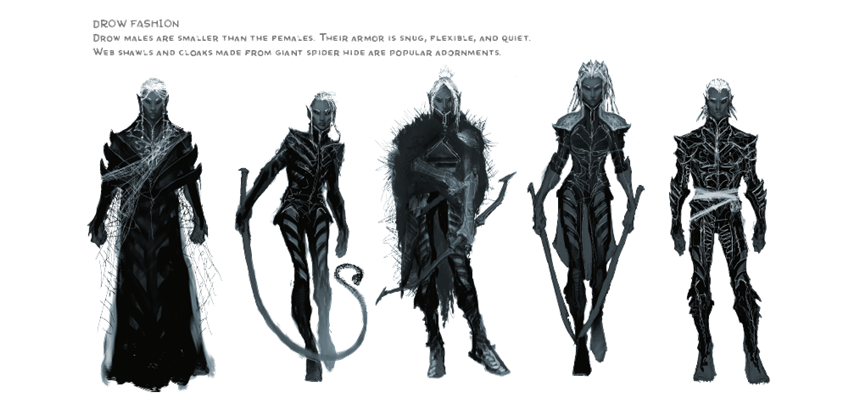
Leaving the Underdark
Playing a dark elf requires both motivation to leave the Underdark and a reason to forgo Lolth’s evil teachings. Male drow have a pretty easy reason; they’re second-class citizens under the Lolthite regime, and the only thing binding them is loyalty to their homeland. You could even be a member (or former member) of Jarlaxle’s all-male Bregan D’aerthe mercenaries, who seek to carve out a name for themselves at bladepoint.
Creating a motivation for female drow is a little bit harder, as they are favored in the eyes of Lolth and her theocrats. Like Liriel Baenre, your character could be fed up with the treachery and cruelty inherent in drow culture. You could be a devotee of Eilistraee and need to feel the touch of moonlight on your face. You could even be great hierarch of your house and you recently survived an assassination attempt by an agent of another house, and felt that fleeing to the surface was safer than gambling on surviving another attempt on your life.
Once this motivation is settled, however, you still need to make your way out of the Underdark. It took Drizzt a whole novel (Exile) to escape this blighted realm, and it takes the first seven levels of Out of the Abyss to escape your drow pursuers and emerge into the realm above. Your journey out of the Underdark needn’t be a great odyssey, but consider defining three major events that happened along the way. If you want to go really in depth, you can try to figure out how each event shaped your worldview and your personality, whether it guided you towards selfishness, compassion, paranoia, bravery, loyalty, or flightiness, and so on. Or not. It’s always your decision on how deep you want your character to be.
Here’s a table you can use to randomly generate some Underdark events. You can create many different encounters, but consider creating three to describe what happened immediately after you left your homeland, what happened in the middle of your journey, and what happened right before you emerged into the world above.
|
d6 |
Type of Encounter |
Creature Encountered |
Outcome of Encounter |
|
1 |
“Out of the shadows jumped…” |
“…a drow exile from Menzoberranzan.” |
“It attacked. I killed it. I moved on.” |
|
2 |
“In the distance, I spotted…” |
“…a gravely wounded mind flayer!” |
“It didn’t notice me, thankfully.” |
|
3 |
“I had a poisoned dart in my leg and fell unconscious. The first thing I saw when I awoke was…” |
“…a group of kuo-toa returning to their village with dinner.” |
“It nearly killed me, but I narrowly escaped.” |
|
4 |
“I heard a horrible screeching in the distance and investigated. It found…” |
“…a drow raiding party returning from the surface, with human slaves in tow.” |
“I thought I could trust it, but it poisoned me, and when I awoke, all of my belongings were gone.” |
|
5 |
“I shared a camp and traded tales with…” |
“…a half-mad human. It must have been an escaped illithid thrall.” |
“I attacked instantly and fled.” |
|
6 |
“I was invited to share rations with…” |
“…a surly duergar.” |
“Somehow, I found a new friend that day.” |
Half-Drow
A simple backstory is that you are not a full-blooded drow from the Underdark at all, but rather a half-elf with drow heritage. You still feel the sting of anti-drow prejudice from the people of the surface, and you will never be accepted by the drow of the Underdark. Nevertheless, you know from the stories your dark elf parent told you about the Underdark that life down there is hell.
The half-drow variant half-elf can be found in the Sword Coast Adventurer’s Guide. Essentially, a half-drow half-elf gains the drow’s “Drow Magic” feature (from the Player’s Handbook) instead of the half-elf’s “Skill Versatility” feature.
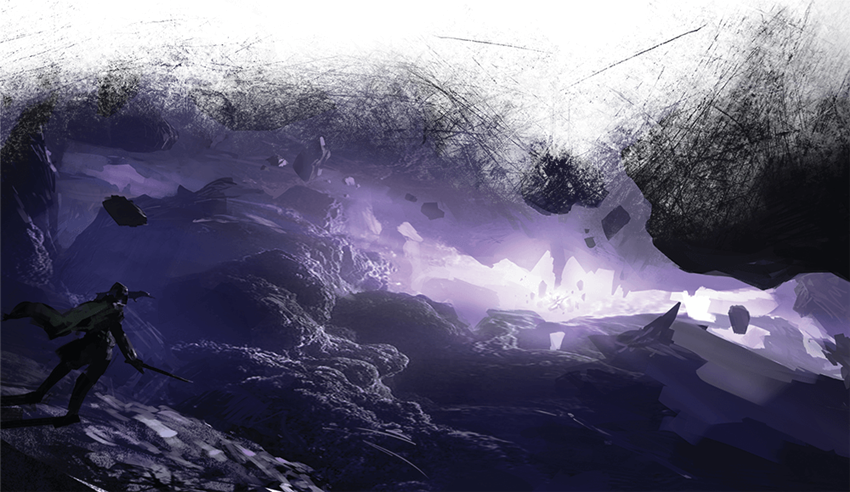
Surviving the Surface World
It isn’t easy being stereotyped. The simple truth of the matter is that drow aren’t inherently evil, but they are led by treacherous people, and an evil society breeds evil citizens. You may be able to, in-character, throw the names of Drizzt Do’Urden and Liriel Baenre in the face of the common racist on the streets of Waterdeep, but logic won’t deter people with an axe to grind. Your best chance to survive and thrive in the world above is to join an organization that will support you. This is probably going to be an adventuring party, but it could also be a faction like the Harpers or the Zhentarim, or even a drow organization like the Bregan D’aerthe. An adventuring party will watch your back when danger is about, and a faction will help give you a safe haven if you can get to their hideout before your enemies do.
One other thing to consider is the sun. There’s no getting around this one; if you’re in an adventuring party, you’ll probably be active during the day when that horrid yellow orb is high in the sky. As a drow, your Sunlight Sensitivity will make it hard to fight in the direct light of the sun. Starting at 3rd level, your innate Drow Magic will allow you to cast faerie fire once per day, which can help negate this disadvantage, but this is only a quick fix. Here are a few solutions:
- Play a spellcasting class. Sunlight Sensitivity only affects Wisdom (Perception) checks and attack rolls, not spells that require saving throws. Using cantrips like acid splash that require a target to make a saving throw instead of fire bolt, which requires you to make an attack roll, circumvents this penalty.
- Talk with your DM about using a weather chart. Unless you’re in the geographical equivalent of Greece, which is sunny 300 days a year, or the Sahara Desert, it’s not going to be sunny all the time. The Sunlight Sensitivity feature only specifies that you take penalties in “direct sunlight,” so a cloudy day isn’t enough to hurt your eyes. If you’re playing a game in Waterdeep (or any other location in the Sword Coast), consider using this weather table; only a result of “sun” is enough to trigger your Sunlight Sensitivity:
Sword Coast Weather Table
|
1d10 |
Type of Weather |
|
1 |
Sun |
|
2 |
Sun |
|
3 |
Overcast |
|
4 |
Overcast |
|
5 |
Rain |
|
6 |
Rain |
|
7 |
Seasonal Weather |
|
8 |
Seasonal Weather |
|
9 |
Seasonal Weather |
|
10 |
Seasonal Weather |
Seasonal Weather: Weather in the Sword Coast changes to fit the season. If you roll “Seasonal Weather,” choose the result below that fits the current season.
- Spring: Rain
- Summer: Sun
- Autumn: Overcast
- Winter: Snow or sleet
Telling Your Own Drow Story
Drow are characters that have a story built in, if you’re willing to explore that story for yourself. If you want to really take control of this story, your best option is to talk with your DM and figure out how they see drow in their setting, whether it’s a version of the Forgotten Realms, their own homebrew, or another D&D world entirely. It would be a tragedy to do your research, create a rich and compelling backstory… and then figure out that all your work was for naught because drow don’t work that way in your DM’s version of the Forgotten Realms.
Figure out why you want to play a dark elf, and you and your DM can work together to make that story come to life. If dealing with fantasy racism just isn’t fun for you, see if your DM will downplay that aspect, or at least give you an easy way to avoid dealing with it. But if you want the full drow package, figuring out a way to not only survive short-sighted prejudice but tear it down can be a whole lot of fun. Don’t be afraid to take risks—after all, you are a drow. Where you come from, danger is everywhere.
 James Haeck is the lead writer for D&D Beyond, the co-author of Waterdeep: Dragon Heist and the Critical Role Tal'Dorei Campaign Setting, the DM of Worlds Apart, and a freelance writer for Wizards of the Coast, the D&D Adventurers League, and Kobold Press. He lives in Seattle, Washington with his partner Hannah and his two midnight raiders, Mei and Marzipan. You can usually find him wasting time on Twitter at @jamesjhaeck.
James Haeck is the lead writer for D&D Beyond, the co-author of Waterdeep: Dragon Heist and the Critical Role Tal'Dorei Campaign Setting, the DM of Worlds Apart, and a freelance writer for Wizards of the Coast, the D&D Adventurers League, and Kobold Press. He lives in Seattle, Washington with his partner Hannah and his two midnight raiders, Mei and Marzipan. You can usually find him wasting time on Twitter at @jamesjhaeck.








-
View User Profile
-
Send Message
Posted Sep 19, 2018I wonder how common or expensive smoked glass spectacles would be. Since they wouldn't have to be prescription you could probably procure a pair fairly cheaply, particularly in a city like Waterdeep which surely has a glassworks that produces coloured or tinted glass.
-
View User Profile
-
Send Message
Posted Sep 19, 2018My wife only ever plays a drow character. It's a treat for me as the DM watching her step into character, develop voice, and see how her character interacts with the all the rest of the group. She often has to earn her keep and struggles to keep surface dwellers at bay. Having a high Charisma can be helpful at times while at other times it becomes a beacon for evil doers who wish to ally with her. Urban adventures are definitely a plus with her around. The party ends up relying on her ability to sneak around. Wilderness adventures can prove equally interesting. Elves aren't trusting of their dark elf kin so when one wanders into the forest alongside humans, dwarves, or half-elves, I have to stop to ask myself: Would this forest protector care? Why? Engage? Attack? Interact? Warn? Capture? Interrogate? All good questions that lead to hours of game play....
-
View User Profile
-
Send Message
Posted Sep 19, 20184-2-6
2-4-6
5-3-6.
I rolled for the three events, each time I made friends. Drow Bard time? Drow Bard time.
-
View User Profile
-
Send Message
Posted Sep 19, 2018Drow female character was rescued from the Underdark by a party of surface dwellers when she still was young. Therefore she did not fall into many of the dark customs and behaviors of the average drow, not she learned too much about them.
Since said adventurers' party had a couple of married high elves in their ranks, they decided to adopt her and train her in the "good ways". She is engaged now with their son (also another of my PCs) and is a priest worshiping a surface good aligned good, different from Eilistraee (depends on the setting).
-
View User Profile
-
Send Message
Posted Sep 19, 2018I refuse to believe that in a land where carpets can fly and cloaks can make you invisible, no one has though to make tinted glasses.
-
View User Profile
-
Send Message
Posted Sep 19, 2018Some DMs may not allow it, but most I've found are pretty flexible, especially once you've played the character from low level to higher and dealt with it for a while.
In our Tyranny of Dragons campaign, the DM allowed me to let my drow librarian warlock customize my Eyes of Minute Seeing once we hit a fairly high level. I ended up calling them the Eyes of the Ultimate Librarian at that point, for thematic awesomeness.
-
View User Profile
-
Send Message
Posted Sep 19, 2018This is truly a great article, this is cool. It makes me think more about the drow pantheon, less of a pantheon innthe traditionnal sense, but more like rulers of various kingdoms, of which Lolth is the biggest and most powerful. Helps me wrap my mind around it. Thank you
-
View User Profile
-
Send Message
Posted Sep 19, 2018Nice as these articles are, I'm hoping we can get back to the class guides soon. I have a player who is very new to D&D and tabletop in general, and I'd like a sorcerer guide I can link her to.
-
View User Profile
-
Send Message
Posted Sep 20, 2018Might we have an article take about Dragonborn someday? They are the PHB race that has the least attention so far in the whole 5e.
-
View User Profile
-
Send Message
Posted Sep 20, 2018I have a Female Drow Cleric of Eilistraee who was born to 2 drow who escaped the underdark and joined a group of surface drow and other followers of Eilistraee. She's lived her whole life on the surface and my DM told me that when I get to play her (whether my current PC dies or for a new campaign), he will rule that sunlight sensitivity doesn't affect her checks and attacks due to her worshipping Eilistraee and having lived on the surface since birth, but he thinks he will lower her darkvision range from 120 to 100 as a trade off due to her being a denizen of the surface instead of being a denizen of the Underdark while still giving her part of the drow advantage in the underdark should adventures take the party there.
-
View User Profile
-
Send Message
Posted Sep 20, 2018I like Half Drow, and Luskan provides such a great backstory
Jarlaxle's drow sleep with locals, who get pregnant. The children are confined to the compound of Ship Kurth so their heritage doesn't blow the drow's cover. Jarlaxle insists they are trained, as he needs agents who can operate on the surface in comfort.
-
View User Profile
-
Send Message
Posted Sep 20, 2018Yeah my very first character in D&D back in the Summer of 1993 was a Drow fighter. This was before Drow were ever a player character race. I played also in Living Forgotten Realms in 4th edition with my famous infamous Drow called Nozareem. He was a Assassin and my friends fan favorite due to his shmoozing the ladies while doing cool flash attacks with his rapier sword. My current Drow is a Necromancer named Tath’myr Xorlarrin from House Xorlarrin younger half brother to Jaemas Xorlarrin and is also a cousin by blood to Matron Mother Zeerith. Tath’myr is my Adventures League character and is currently a 16th level Necromancer. He is Evil to the core but works well with others with the occasional RP arguments or fussing, like when the cleric of Kelemvor or Lothander or good aligned Paladin see him attempting to create or animate dead or summon a demon to aid the group in combat🤷🏼♂️😈. He also has a Genius intelligence and part of his long back story I have for him, he was another Xorlarrin prodigy while attending Sorcere the Menzoberranzen school of magic and mastered the more darker arts while there and now after graduated has had a very interesting life for a male Drow that has given him great priviliage and success in his indevers while on the surface and in the Underdark. He is also a high ranking member of Lords Alliance as a War Duke that gained from being a liaison from House Xorlarrin. Notable things about him is he has a keen interests in all things of magic and lore that are usually vile, secret or forbidden to learn hence his mastery over creating undead and summoning demons and devils and creating grave elemental or blood elemental or Peyer elemental. At the moment he is on the hunt for “The Book of Vile Darkness” to increase his knowledge of all things evil and forbidden 🕷🕷🕸🕸🧟♂️💀😈💯
-
View User Profile
-
Send Message
Posted Sep 20, 2018How distinct are her drow characters? Does she start off with basically the same character every time, who then grows and evolves with the circumstances of the campaign? Or is every one of her drow completely different?
Either way, it sounds like a lot of fun for everyone.
-
View User Profile
-
Send Message
Posted Sep 20, 2018So question on this, a half-elf half-drow. I imagine this obviously pertains to a human/drow offspring. Is this also meaning a Drow and surface elf offspring?
-
View User Profile
-
Send Message
Posted Sep 20, 2018Great article! I just made a half drow Gloom Stalker Ranger and I'm definitely using some of the info and tools here to flesh out her backstory. Thanks!
-
View User Profile
-
Send Message
Posted Sep 20, 2018It has been said by the designers it's not normal light sensitivity and tinted glasses or goggles do little to solve the problem; it's a supernatural curse that triggers something akin to an allergic reaction.
-
View User Profile
-
Send Message
Posted Sep 20, 2018The last DM I played with allowed me two options when I went to play my (now old) Drow character when it came to sunlight sensitivity
1: Be of young (or closer to young) age and relatively new to the surface still, but eventually find a way to negate it (DM had a custom magic item in mind to counter the penalty)
2: Be of older age (anything over late 30's) and have already gotten used to the surface and/or even already discovering a way to counter it
I picked option 1, cause the idea of getting used to being new to the surface and having to find ways to work with or around the sunlight sensitivity was exciting to me. In the end tho, it was cool that the DM was giving me the options.
The Drow character was a female rogue, being trained by Lolth priestesses to be an assassin to take out their own kind (for whatever reason that might be) and help in capturing surface dwellers for slavery. However, she was more interested in exploring new places and not being constrained to such petty beliefs (she wasn't a follower of any specific god, tho has caught mentions of the others that the priestesses wanted to keep quiet). She eventually made her escape one day at the age of 19 (rolled for age, lowest possible being 16 and highest being 31) and discovered the beauty and wonders of the surface 'world'. She had a pretty hard time being accepted by the surface folk but eventually made a name for herself and earned enough respect to join up with an adventuring group (the other players). She never even heard of Drizzt and them until much later in her advenures
-
View User Profile
-
Send Message
Posted Sep 20, 2018I wanted to make a drow that was still evil but wouldn't simply break an otherwise good party. So I decided to make him a forced sorcerer to an Ancient Bronze Dragon who he tried to clip the wings of. He was "successful" but while he was bathed in her blood she imposed sorcery upon him. He stole her freedom so she stole his. Now he either does good in her stead or he gets tortured by lightning (LG- He will be punished one way or another.) I think he'd be a fun character to play so I've kept him in my back-up roster but I may just DM with him as an NPC soon.
This article helped a good amount. I had him as a second son and third child of a prominent Drow family. His brother and sister filled the typical roles of mage and priestess so he became more of a free agent and prankster. He was also an accomplished scout. All of that and his ambition is what lead him to go try to dispatch the dragon when he heard of it nearing his city's caves. Considering these things and what I just learned about Zinzerena I think I have some good in-world details to flesh him out as different,
-
View User Profile
-
Send Message
Posted Sep 20, 2018I played (DM left, group is still going, so could play again one day) a half-drow Paladin of Conquest. Essentially his backstory was that he was the product of a drow raiding party coming to the surface and leaving behind a little bundle of joy in a local lord's daughter. Raised by humans, he never saw a Drow until meeting the Black Spider, and he was sent to be trained as a Paladin to hopefully curb his race's chaos.
I played him as a very locked-down Lawful Neutral character who cared deeply about civilization, the Lords' Alliance, and his dream of one day subjugating goblinoid races in the name of civilization.
He wore smoke glass spectacles.
-
View User Profile
-
Send Message
Posted Sep 21, 2018What a great article! I love how much thought has gone into the Drow and how many interesting ways they can be played! Im not a fan of entire races being considered evil, so I appreciate explaining why Drow would be predisposed to evil but also giving ways for players to have a none evil drow!
Excited to read articles like this about some of the other rarer races. :)